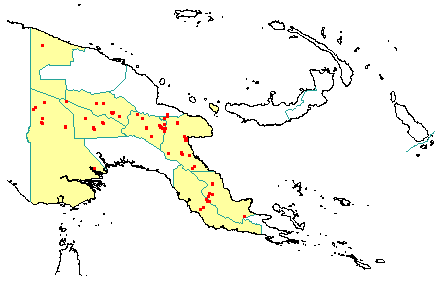
in PNGplants database
PNGTreesKey – Lithocarpus rufovillosus (Markgr) Rehder |
Barry Conn (NSW) & Kipiro Damas (LAE).
Guide to trees of Papua New Guinea
Copyright held by the authors, National Herbarium of New South Wales, and Papua New Guinea National Herbarium
Journal of the Arnold Arboretum Vol. 10: 133 (1929)
Other Literature: E. Soepadmo, Flora Malesiana, Series 1, 383-384 (1972)
Family: Fagaceae
Dicotyledon
Timber Group: Major exportable hardwood
Field Characters: Large canopy tree (15-40 m high) or Small sub-canopy tree; Bole cylindrical (up to 55 cm diam.); straight (bole up to 20 m long); buttresses buttresses absent; spines spines absent; aerial roots aerial roots absent; stilt roots stilt roots absent; Bark grey or pale to dark brown, rough, scaly or flaky, fissured, slightly peeling, or slightly pustular, lenticels elongated laterally; Subrhytidome (under-bark) green, red (lines), brown, or purple; less than 25 mm thick, 5.0-12.0; bark blaze with two layers; faintly to non-aromatic; outer blaze brownish red or pale brown, markings absent; inner blaze white, pale yellow, or pale brown, markings absent; bark exudate (sap) present, colourless, not readily flowing (spotty), colour changing on exposure to air, to brown or purple, not sticky; terminal buds not enclosed by leaves.
Indumentum: Complex hairs present, star-like (stellate); stinging hairs absent; mature twig indumentum (hairs) present or absent (later glabrescent), hairs dense to sparse.
Leaves: Leaves spaced along branches, spiral (leaves occurring singly at a node and arranged spirally up the branchlet), simple (a leaf composed of a single blade); petiole present, not winged, attached to base of leaf blade, not swollen; leaves broadest at or near middle to broadest below middle, (6.0-) 10.0-15.0 (-18.0) cm, (3.0-) 4.0-6.0 (-8.0) cm; symmetric (often slightly asymmetric), entire, not dissected or lobed, bluntly acute or acuminate, venation pinnate, secondary veins open, prominent (6-)7-8(-9) pairs), intramarginal veins absent; leaves lower surface brown or red, upper surface dark brown, indumentum (hairs) present (initially with woolly hairs below or reddish stellate hairs below), indumentum (hairs) dense or sparse (soon glabrescent); absent; domatia absent; stipules present, free, laterally placed, not encircling the twig, ovate leafy, not fringed, large (3-5 mm long), not persistent.
Flowers: Inflorescence terminal (sub male), axillary, or leaf-opposed, flowers single (female) or flowers on a branched axis (male in clusters of 3s), cones absent; flowers unisexual, unisexual with male and female flowers on the same plant, not stalked, flowers slightly asymmetric, 2.0-3.0 mm long, diameter small (up to10 mm diam.) (c. 3 mm diam.); perianth present, with all sepals and/or petals (hence tepals) similar, inner perianth pale yellow; 6, some or partly joined; stamens 10-(staminodes in female flowers)-12, present, free of each other, free of the perianth; ovary inferior, carpels joined (when more than one), locules 2-6 (-9); styles free, 3-4.
Fruits: Infrutescence single, fruit 20.0-30.0 mm long, dark brown, not spiny, non-fleshy, simple, indehiscent, nut; seeds 1, much more than 10 mm long (c. 15 mm long), not winged, broad (as wide as long), seed 1-10 mm diam.
Distribution: West Sepik, Morobe, Western Highlands, Eastern Highlands, Southern Highlands, Western, Central & Northern.
 | Botanical records in PNGplants database |